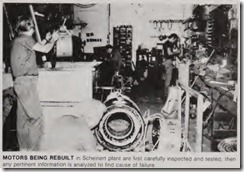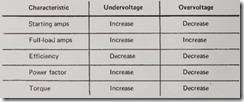TROUBlESHOOTING and MAINTENANCE
Why motors fail
By RICHARD SCHEINERT
WHEN A MOTOR comes into our plant for repair, we inspect it thor oughly, searching carefully for the pos sible cause of failure. Pinning down the exact cause is not easy; often the source of trouble has been obscured by burned windings or other misleading “faults.” For example, the motor windings may be badly burned; but closer examina tion may reveal a damaged ball-bear ing that could have caused the rotor to rub on the stator windings. Taking this analytical thinking process a little far ther-why did the bearing fail? Was it misalignment , excessive loading, or simply a lack of proper lubrication?
Many motor failures can be averted, or at least the useful life of a motor can be extended, if proper preventive mea sures are taken. And an important part of this process is knowing why motors fail.
We have found that sources of motor troubles generally fall into one of the following categories:
(1) Harsh environment
(2) Improper motor selection/application
(3) Inadequate installation
(4) Mechanical failure
(5) Electrical problems
(6) Voltage unbalance
(7) Inadequate maintenance
(8) Combination of one or more of the above.
Harsh environment- Frequently, excessive temperature (whether it is caused by the environment or by a problem within the motor) is a cause of motor failure. Motors must operate within their nameplate temperature rise rating to assure long motor life. For every 10 degrees a motor is oper ated above its rating, the insulaton life of the motor is halved.
In addition to maintaining proper ambient temperature, other sources of elevated temperature must be found and eliminated. These sources could include misalignment, overload, incor rect voltage, and many others. Other harmful environments include those containing corrosive fumes or vapors, salt-laden air, and excessive dirt, dust, or other contamination. In these loca tions, motor enclosures designed for the surrounding atmosphere or condi tions are essential.
Moisture is another common source of motor failure. If moisture forms on the surface of the insulation because of high humidity, temperature change, or direct exposure to water, the insulation surface may become highly conductive and result in an insulation failure and immediate motor failure. Also, it is possible for the insulation to absorb moisture over a period of time until the insulation resistance becomes so low that the fault occurs.
Improper motor selectionlapplication-The variations and degree of incorrect selection and application vary greatly. Sometimes the misapplication is so minor that the motor survives for a significant time. It is essential that the proper size and type of motor be selected for the load. The motor manu facturer, your local service firm, and motor standards can provide guidance. There are numerous factors to consid er. As an example, a severe duty cycle could cause premature motor failure. Jogging, plugging, and long accelera tion cause motors to run at lower than-normal speeds. Because they draw high currents when starting, motors subject to these duty cycles will often experience excessive heating be cause of the higher currents. Also, nor mal cooling derived from the revolving rotor will be greatly diminished, add ing to the overheating problem.
Consideration of altitude is another important application factor often overlooked. At high altitudes, the lower air density reduces the effectiveness of cooling air. This reduced cooling permits the running temperature of most motors to increase approximately 5% for each 1000 ft of elevation.
Selection of the proper motor enclosure is important. Standard motor enclosures are available for practically any situation.
Inadequate installation- Faults in motor mounting can cause motors to fail. If mounting bolts are not tight ened or not sized properly, misalign ment or vibrations occur, resulting in bearing and shaft failures and eventual winding burnout. Mounting steel, foun dations and grouting must be strong enough to withstand starts and stops.
Couplings, belts, sheaves and any other connections between the motor and driven load must be aligned cor rectly to avoid excessive vibration that is so damaging to motors.
Also, inadequate installation occurs when the proper attention is not given to the NEC and other standard instal lation practices. Article 430 of the NEC and NEMA standards provide installa tion guidance.
Mechanical failure-An excessive load can quickly result in motor failure. The motor may have been properly sized for its load initially; however, a change in the load, or in the connecting drive, could result in overloading of the motor. Bearings may begin to fail, gears may begin to bind, or any source of additional friction or load can occur. When this happens, the motor will draw additional current, resulting in increased motor temperature. If the motor current exceeds rated full-load current for any length of time, the overheating will shorten motor life. Very high overcurrents should trip the overload relays if they have been prop erly sized.
Bearing failures are one of the most common causes of motor failures. It has been estimated that up to one-half of all motor burnouts have been caused by a bad bearing. The many causes of bearing failures and techniques to properly maintain bearings should be thoroughly understood.
Misalignment of motor and driven load, couplings, gears, pulleys, and belts are all mechanical causes of motor failure. All components should be dynamically balanced to assure best possible conditions for long motor life. This will, in addition, minimize vibra tion and associated problems.
Electrical problems-Incorrect supply voltage to a motor will shorten life and could cause rapid failure if voltage deviation is excessive. Low voltage will cause higher-than-normal current. If the voltage decrease is severe enough, the excessive current will cause the motor to overheat.
A high line voltage to the motor reduces copper losses; but the increased magnetic flux results in higher iron losses. A small increase in supply volt age could reduce the current drawn by the motor; however, higher increases on the order of 10% or more over nameplate voltage-will cause satura tion of the iron and a significant increase in current with the accompa nying harmful overheating of the
motor.
Unbnlnnced voltages- Unbalanced 3-phase voltages to a motor can result in a very high current unbalance. Very high motor currents can occur, result ing in fast overheating. Protection must be provided against this kind of problem, and oV€rload relays usually can do the job. Recently, new types of overload relays have been successfully applied to protect the motor not only from unbalanced voltages but also from single phasing-which in actuali ty is an extreme form of voltage unbal ance.
Inndequate maintenance- Frequently, basic preventive maintenance could prevent or at least delay the failure of a motor. When our trouble shooters have visited certain locations, they report conditions such as dust and dirt on motors or clogged ventilation passages, hot-running motors, incor rect motor currents, noisy bearings, moisture in the area of the motor-all of which indicate a lack of planned regular maintenance.
Certainly not all motors need or deserve preventive maintenance, par ticularly where the maintenance costs would exceed the cost of that motor failure. On the other hand, where the motor is applied in a critical applica tion or is large, expensive or hard to replace, then a preventive maintenance program is well justified. We have made such surveys for industrial plants and, as a result, their production is more reliable, motors last longer, and total operating costs lower.
VOLTAGE AND FREQUENCY VARIATIONS
Induction motors will operate suc cessfully under running conditions at rated load with a voltage variation of ± 10% at the motor terminals. A frequency variation of ±5% is permis sible. A combined variation of voltage and frequency of ±·10% is acceptable, provided the frequency variation does not exceed ± 5% of rated frequency. For example, the voltage could vary by a maximum of ± 7% and the frequency by a maximum of ±3%. The combined variation does not, exceed ±10%. However, some loss in performance occurs when a motor is operated at other than rated values.
A 5% increase in frequency will increase the speed of the motor about 5% and will increase the efficiency, power factor, and full-load current slightly. Torque will drop about 10%. A 5% decrease will increase the torque about 11%, decrease the speed about 5%, and slightly decrt::ase the efficien cy, PF and current.
The accompanying chart shows how motor characteristics are generally affected by voltage deviations.

